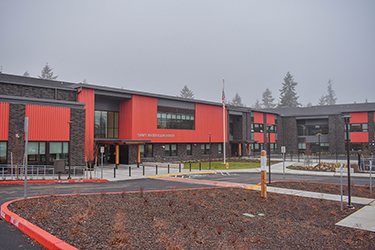|
Subscribe / Renew |
|
|
Contact Us |
|
| ► Subscribe to our Free Weekly Newsletter | |
| home | Welcome, sign in or click here to subscribe. | login |
Architecture & Engineering
| |
 |
March 30, 2023
Engineering gets specialized in response to increasing complexity
AHBL

McEachern
|
Engineering is an exciting field that is constantly evolving with new discoveries and advances in building technology and application. Along with the entire field evolving, each specialty, such as civil engineering and structural engineering, continues to advance as we discover new and better ways to build safe and efficient structures while meeting the current demands placed on modern buildings, such as overall carbon content and energy efficiency.
ENGINEERING SPECIALIZATION
In the relatively recent past, the complexity of building design required a movement away from the architect/master builder model to an arrangement of several team members that focused their efforts on a specific aspect of building design and construction. Structural engineering was initially performed as part of the scope of the civil engineer. The increasing complexity of building structural design led to further specialization, with structural engineering eventually being considered a separate sub-discipline of civil engineering.
In the early 20th century, civil engineers began a push to regulate structural engineering due to the construction of more complex buildings as well as the result of damaging earthquakes. The legislation intended to ensure qualified people were involved in the design of modern buildings that were becoming increasingly taller and larger.
The perceived risk of structural failure for these larger buildings created a desire to protect public health, safety, and welfare. In Washington state, most building structures can still be designed by a licensed civil engineer. For decades, Washington has also maintained a “title act” whereby only a licensed structural engineer may use the title of structural engineer. Relatively recently, Washington state has also passed a “practice act” that requires licensed structural engineers to design structures defined as “significant structures.” The Revised Code of Washington identifies building types that meet the requirements of “significant structures,” which include hospitals, fire, and police stations, buildings over 100 feet in height, and similar structures.
The ongoing evolution of engineer licensing and regulation in Washington state highlights the increased specialization within this field as design requirements for buildings continue to increase in complexity.
Other specialized engineering fields that have evolved into their discipline from their roots in civil engineering include: transportation; geotechnical; environmental; and water resource.
Traditionally, while an architect determines the overall building layout and function, the structural engineer is entrusted with the safety of the building occupants and the public. They evaluate structural demands on the building systems by calculating the loads and stresses due to self-weight, occupant loading as well as snow, wind, and earthquake forces. They also help determine the materials that will best meet the project requirements when considering other factors such as building size, occupancy/use, cost, and location. The most common options for building materials include steel, concrete, masonry, and wood.
Structural engineers utilize building codes that are constantly evolving. The building codes consist of a national building code (IBC or ASCE 7) that is adopted by Washington state and local jurisdictions, as well as material-specific codes (ACI for concrete, AISC for steel, ACI/TMS for masonry, AWC for wood and others). The considerable volume of structural guidelines and requirements has resulted in a need for specialization of some engineering practitioners.
This specialization allows for increased efficiency of structural engineering as well as engineering solutions that benefit from the increased proficiency and expertise of the practitioner. In many cases, the engineer may work directly with a specialty contractor rather than the project design team. Examples of areas of specialization in structural engineering include:
• Conventional wood trusses, plywood web joists, open web steel joists, and similar building components.
• Manufactured metal buildings primarily used for shops and similar commercial building.
• Exterior curtain walls and interior non-structural partition walls.
• Steel stairs, catwalks, and mechanical platforms.
• Buckling restrained braces and similar proprietary elements of the lateral force resisting system.
• Long span structures or high-rise structures.
• Wind or seismic engineering for significant structures.
• Structural peer reviews for significant structures.
In addition to the specialization of structural engineers, the deliverables produced by project teams have become more complex. As structural drawings have evolved from the original hand-drafted plans and details to CAD drawings to 3D building models, the industry has seen drafters and technicians who also focus on a specific type of software. We anticipate that additional specialization will occur as the technology involved in our industry evolves.
EVOLUTION OF TECHNOLOGY
The field of engineering continues to evolve and adapt to changes in our environment, building codes, lessons learned from building failures as well as the adaptation of increased technology in the field. The latest innovation in technology that is starting to affect how we work includes:
• Artificial intelligence in engineering and construction — schedule management, project planning, and data collection to refine quality control. AI programs can provide automation for low-value tasks, freeing up engineers to perform higher-value tasks.
• Digital twin — a CAD model provides visualizing pieces of a larger puzzle in 3D, allowing for instant design modification before manufacturing. A digital twin goes beyond that capability; adding information about failures, stresses, maintenance schedules, and other data, and then combining it with the speed of communications technology, and you get something else beyond a CAD model: you get a digital twin.
• Augmented and virtual reality — visualizing high volumes of complex data. Because engineers can work with high volumes of data with complex characteristics, they can use VR to create immersive representations of data they can view and interact with easily.
• Drone photography — safer access to sites and structures, by avoiding hazards such as working at heights, or working over water, or along steep slopes; faster and cost-effective data acquisition, especially over large sites and for repeated surveys; easy integration with LiDAR data and input to GIS and CAD software.
At AHBL, our structural engineers are constantly working to improve their familiarity with the latest technology as well as our understanding of building code requirements (most Washington jurisdictions will be updating to the newest code as of July 1). Maintaining a culture of life-long learning allows us to implement the latest thinking in the field of structural engineering and use these resources for the benefit of our clients and projects while ensuring public safety is maintained.
Drew McEachern is an AHBL principal.
Other Stories:
- In Edmonds, a park runs through it
- Equitable development: nice to have or essential best practice?
- At Glover Middle School, the lighting runs through it
- Engineering solutions, as waters rise
- Revitalizing downtowns with office-to-residential conversion
- Structures and sustainability: pursuing net-zero carbon emissions
- Employee ownership for all: an alternative to the ESOP
- New form of team work needed for multifamily projects
- So you want to be a rock star (marketer)
- Natural direction is a new path in architecture



